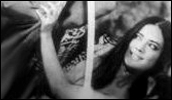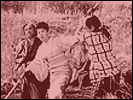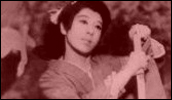The Crimson Bat – Blind Swordswoman
- Year
- 1969
- Original title
- Mekura no Oichi Monogatari Makka na Nagaredori
- Japanese title
- めくらのお市物語 真っ赤な流れ鳥
- Director
- Cast
- Running time
- 85 minutes
- Published
- 20 March 2001



by Jasper Sharp
The chanbara genre was very much in vogue in the late 1960s and early 70s. Some of the best known sword-and-samurai actioners were released between these dates, peaking with the quintessential Lone Wolf and Cub series (Kozure Okami, 1972-'74). The individual characteristics of these period piece potboilers were fixed around the personality of their central protagonists. The films were released in gluts within a short period of time until the public got bored of them, the various episodes within the serial format pretty much interchangeable. The success of the Daiei studio's Zatoichi series - which resulted in 25 films made between the years 1962-'73, starring Shintaro Katsu as the charismatic blind swordsman - no doubt inspired Shochiku to subvert the concept through a swift gender twist, and hey presto, Blind Oichi was conceived.
Yoko Matsuyama, already well known to the Japanese public in the 60s due to her leading TV role in Seven Faces of Princess Koto (Kotohime Shichi Henge), here takes to the big screen as the eponymous sightless swordswoman - a character developed in a successful manga comic by her husband Teruo Tanashita. Deserted by her mother when blinded in a storm as a child, she is on a perennial quest to find the killers of her father.
The film under review here being the first of the series, a good part of the running time is given over to flashbacks establishing the character and background of the kimono-clad avenging angel. There's the usual Edo period flavour, bright colours and stylised sequences of gymnastic swordplay, but essentially little else other than the attractive facade presented by Blind Oichi herself.
There are few plot intricacies and surface details to distinguish this from other genre offerings of the period such as the Wicked Priest series (Gokuaku Bozu, 1968-'74), an early outing for Lone Wolf star Tomisaburo Wakayama. The dubbed video release seen here added to the charm, and it goes without saying that if you like martial arts films, you'll no doubt take to this. Personally I found Toshiya Fujita's similar Lady Snowblood (Shurayukihime, 1973), which also had the virtue of only stretching to one sequel, to be rather more satisfying.
The Blind Oichi series, released in the West under the Crimson Bat monicker, ran for another three films until Matsuyama hung up her blade to raise a family, the other films in the series being Trapped! The Crimson Bat (1969); Watch Out, Crimson Bat! ('69) and Crimson Bat: Wanted Dead or Alive ('70).